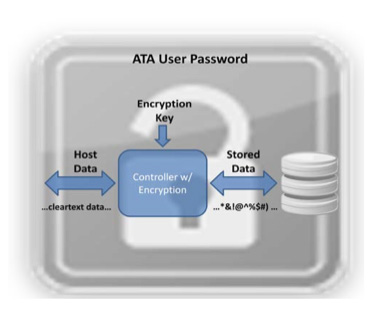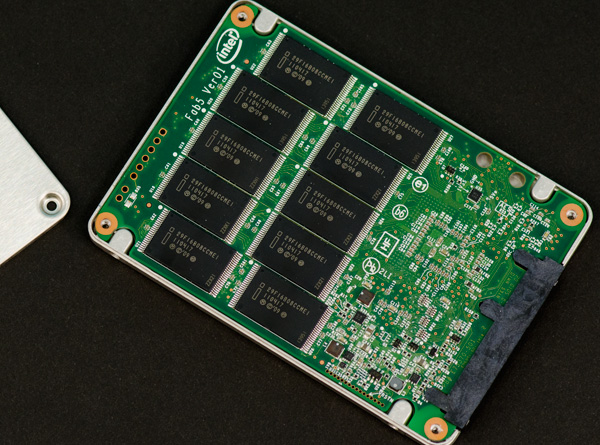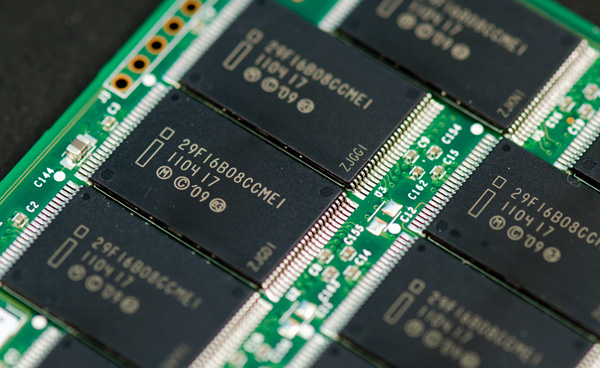The Intel SSD 320 Review: 25nm G3 is Finally Here
by Anand Lal Shimpi on March 28, 2011 11:08 AM EST- Posted in
- IT Computing
- Storage
- SSDs
- Intel
- Intel SSD 320
Spare Area and Redundant NAND
Intel's controller is a 10-channel architecture and thus drive capacities are still a little wonky compared to the competition. Thanks to 25nm NAND we now have some larger capacities to talk about: 300GB and 600GB.
Intel sent a 300GB version of the 320 for us to take a look at. Internally the drive has 20 physical NAND devices. Each NAND device is 16GB in size and features two 64Gbit 25nm 2-bit MLC NAND die. That works out to be 320GB of NAND for a drive whose rated capacity is 300GB. In Windows you'll see ~279GB of free space, which leaves 12.8% of the total NAND capacity as spare area.
Around half of that spare area is used to keep write amplification low and for wear leveling, both typical uses of spare area. The other half is for surplus NAND arrays, a RAID-like redundancy that Intel is introducing with the SSD 320.
As SandForce realized in the development of its controller, smaller geometry NAND is more prone to failure. We've seen this with the hefty reduction in rated program/erase cycles since the introduction of 50nm NAND. As a result, wear leveling algorithms are very important. With higher densities however comes the risk of huge amounts of data loss should there be a failure in a single NAND die. SandForce combats the problem by striping parity data across all of the NAND in the SSD array, allowing the recovery of up to a full NAND die should a failure take place. Intel's surplus NAND arrays work in a similar manner.
Instead of striping parity data across all NAND devices in the drive, Intel creates a RAID-4 style system. Parity bits for each write are generated and stored in the remaining half of the spare area in the SSD 320's NAND array. There's more than a full NAND die (~20GB on the 300GB drive) worth of parity data on the 320 so it can actually deal with a failure of more than a single 64Gbit (8GB) die.
Sequential Write Cap Gone, but no 6Gbps
The one thing that plagued Intel's X25-M was its limited sequential write performance. While we could make an exception for the G1, near the end of the G2's reign as most-recommended-drive the 100MB/s max sequential write speed started being a burden(especially as competing drives caught up and surpassed its random performance). The 320 fixes that by increasing rated sequential write speed to as high as 220MB/s.
You may remember that with the move to 25nm Intel also increased page size from 4KB to 8KB. On the 320, Intel gives credit to the 8KB page size as a big part of what helped it overcome its sequential write speed limitations. With twice as much data coming in per page read it's possible to have a fully page based mapping system and still increase sequential throughput.
Given that the controller hasn't changed since 2009, the 320 doesn't support 6Gbps SATA. We'll see this limitation manifest itself as a significantly reduced sequential read/write speed in the benchmark section later.
AES-128 Encryption
SandForce introduced full disk encryption starting in 2010 with its SF-1200/SF-1500 controllers. On SandForce drives all data written to NAND is stored in an encrypted form. This encryption only protects you if someone manages to desolder the NAND from your SSD and probes it directly. If you want your drive to remain for your eyes only you'll need to set an ATA password, which on PCs is forced by setting a BIOS password. Do this on a SandForce drive and try to move it to another machine and you'll be faced with an unreadable drive. Your data is already encrypted at line speed and it's only accessible via the ATA password you set.

Intel's SSD 320 enables a similar encryption engine. By default all writes the controller commits to NAND are encrypted using AES-128. The encryption process happens in realtime and doesn't pose a bottleneck to the SSD's performance.
The 320 ships with a 128-bit AES key from the factory, however a new key is randomly generated every time you secure erase the drive. To further secure the drive the BIOS/ATA password method I described above works as well.
A side effect of having all data encrypted on the NAND is that secure erases happen much quicker. You can secure erase a SF drive in under 3 seconds as the controller just throws away the encryption key and generates a new one. Intel's SSD 320 takes a bit longer but it's still very quick at roughly 30 seconds to complete a secure erase on a 300GB drive. Intel is likely also just deleting the encryption key and generating a new one. Without the encryption key, the data stored in the NAND array is meaningless.
The Test
| CPU |
Intel Core i7 965 running at 3.2GHz (Turbo & EIST Disabled) Intel Core i7 2600K running at 3.4GHz (Turbo & EIST Disabled) - for AT SB 2011, AS SSD & ATTO |
| Motherboard: |
Intel DX58SO (Intel X58) Intel H67 Motherboard |
| Chipset: |
Intel X58 + Marvell SATA 6Gbps PCIe Intel H67 |
| Chipset Drivers: |
Intel 9.1.1.1015 + Intel IMSM 8.9 Intel 9.1.1.1015 + Intel RST 10.2 |
| Memory: | Qimonda DDR3-1333 4 x 1GB (7-7-7-20) |
| Video Card: | eVGA GeForce GTX 285 |
| Video Drivers: | NVIDIA ForceWare 190.38 64-bit |
| Desktop Resolution: | 1920 x 1200 |
| OS: | Windows 7 x64 |













194 Comments
View All Comments
Morten.DK - Monday, April 11, 2011 - link
One thing that bothers me a bit: It seems that the smaller drives has a lower spare area percentage than the 300GB drive.120GB: Physical 120GB, user capacity 111GB, spare ares 9GB which is 7.5%
160GB: Physical 160GB, user capacity 149GB, spare area 11GB which is 6.9%
300GB: Physical 320GB, user capacity 279GB, spare area 41GB which is 12.8%
600GB: Phycical 640GB, user capacity 558GB, spare area 82GB which is 12.8%
Does this mean that the smaller drives does not have the same RAID4-like redundancy as the 300GB drive? Or am I wrong about the physival sizes of the smaller drives?
noblemo - Thursday, April 14, 2011 - link
There are two factors in your calculation: 1) spare area, and 2) GB to GiB conversion. I believe the spare area is as follows:120 GB: 128-120 = 8 GB spare area = 6.25%
300 GB: 320-300 = 20 GB spare area = 6.25%
600 GB: 640-600 = 40 GB spare area = 6.25%
I am not sure about the 160GB model; if it uses six 32GB chips, then the spare area is 16.7%. If it uses five 32GB chips, then there is no spare area.
To convert GB to GiB, divide by 1.024^3:
120 GB = 111.8 GiB
160 GB = 149 GiB
300 GB = 279 GiB
600 GB = 559 GiB
So the 120 GB drive has 128 GB total area and 8 GB spare area (6.25%). This is equivalent to 111.8 GiB with 119.2 GiB total area and 7.45 GiB spare area (6.25%).
noblemo - Friday, April 15, 2011 - link
My previous post was incorrect. The 300GB and 600GB drives have 12.8% spare area, while the smaller drives have 6.8%.mattr00 - Sunday, April 17, 2011 - link
Hey Anand,Thanks as always for a great review. Is there any ETA on benchmarking the 120GB version of this? All of the reviews I see online are 300GB and I'm itching to know whether the 120GB performance is significantly lower than the 300GB performance. I'm considering buying the 120GB, but it has lower IOPS write performance than 300GB according to Intel specs, which I fear will mean low random write performance in the real world.
Thanks!
Surlias - Saturday, April 23, 2011 - link
I've been unable to find a review comparing the 40gb G2 and the 40gb G3 models. Anyone have any experience with both of these models, or perhaps can point me to a review of the 40gb G3 somewhere? I'm sitting on an unopened G2 trying to decide if I want to go to the trouble of exchanging it for a G3. I'd save a few bucks in the process, but if the performance isn't any better then I'd just as soon stick with the G2 and its proven reliability.ross999 - Tuesday, April 26, 2011 - link
I know the documentation says that an ATA password is required to use the device level encryption, and that Mac's OS EFI password isn't quite the same. However, I've spoke with both Intel and Apple, and neither can provide any details about compatibility of these passwords for purposes of encryption. Really, Intel, you don't know if it will work with MacOS? Bizarre.Can anyone shed first-hand knowledge on this?
MB17 - Saturday, May 7, 2011 - link
Cost difference is little to consider for me, so if someone can help:On 3 GBPS systems, I understood that the Intel 320 is a little bit better in real life performance than the 510. Is this correct?
Also, 510 is a little more future proof (if I ever change to a 6GBPS system) and 320 gives me more storage space, right?
These seems to be my main points of consideration, right, or am I overlooking something?
Any definitive reason to buy one over the other?
Thanks so much for any help.
PS: How much free space do I get from the 510 (unlike the 320 I could not find this info)
garuda1 - Monday, May 23, 2011 - link
Does anyone know why Intel's Toolbox won't TRIM an SSD mounted in an external enclosure. It will migrate, but won't TRIM. Intel responded in an email by only saying:“We don’t validate or authorize use of SSD Optimizer through eSATA enclosures. If a customer wants to use an eSATA enclosure, they must understand they are using a configuration that is not validated by Intel and they are on their own.
-If customer wants to use Optimizer on an Intel SSD, suggest they connect it directly to the host system."
But is there a specific reason for this? And will Intel eventually modify the Toolbox to accommodate external SSDs in the near future. Once the host system case is full, the only alternative is external enclosures. Is there some design or F/W limitation that precludes externals?
P.S. - Intel's FAQ section on their website specifically mentions that SSDs are compatible with external eSATA enclosures (unless they recently changed it). This is what led me to believe that my recent purchase of two S320 600GB SSDs would function and optimize in external eSATA enclosure which I also purchased. Thanks for any feedback.
garuda1 - Monday, May 23, 2011 - link
Note question and answer# 4 in the following link at Intel FAQs:http://download.intel.com/support/ssdc/hpssd/sb/in...
hoofy - Monday, August 22, 2011 - link
I am really concerned how the 40GB SSD 320 will perform as i am planning to buy it as an OS drive. My other options are vertex 2 40GB and X-25-V 40GB. Please recommend me guys the best drive among these three.